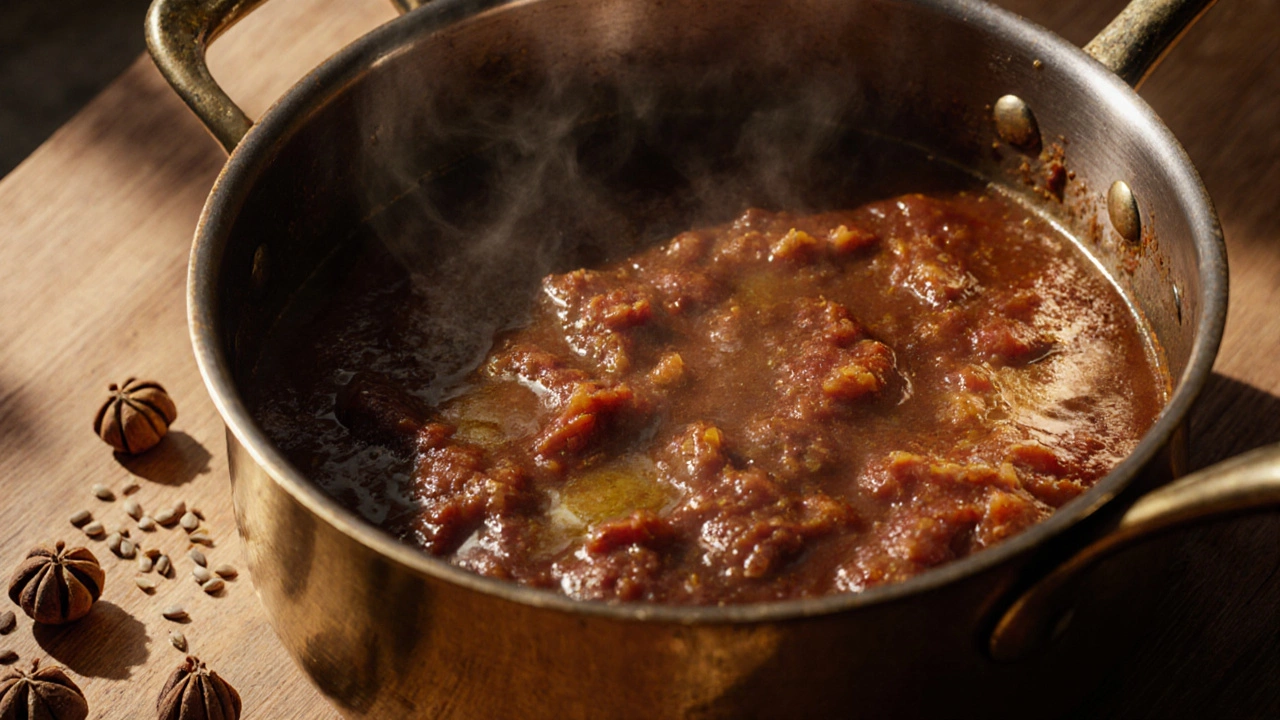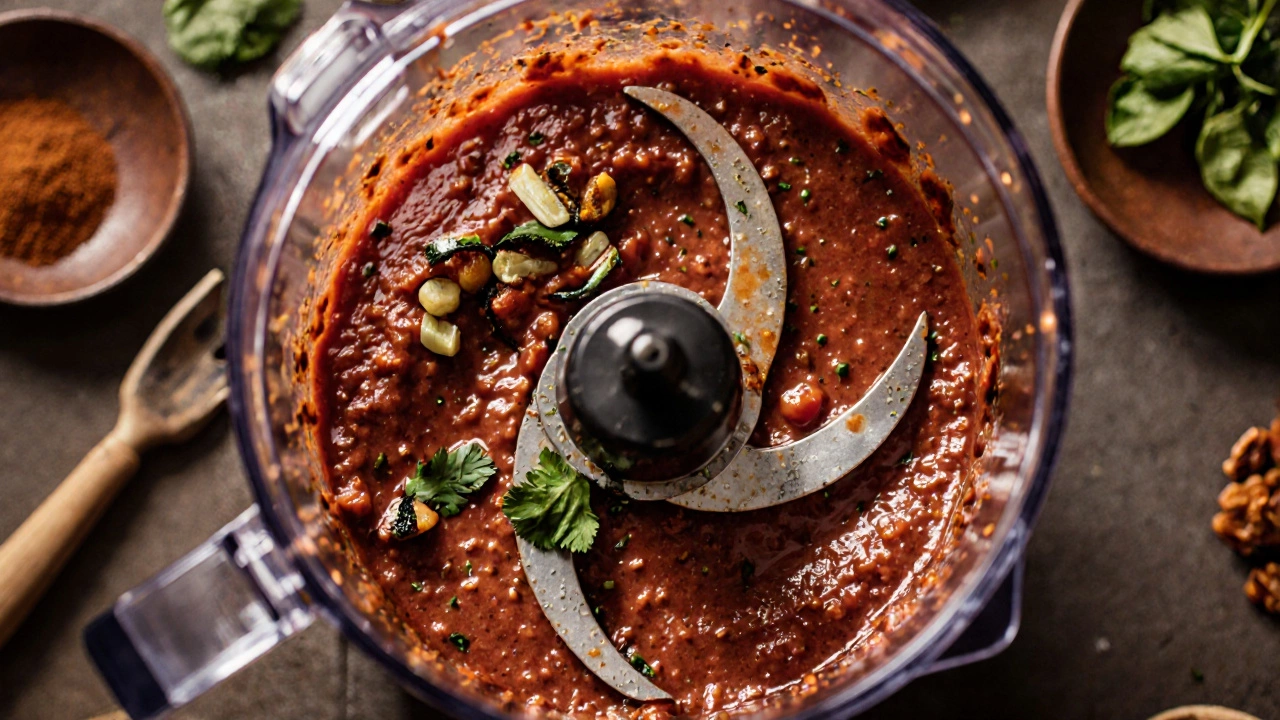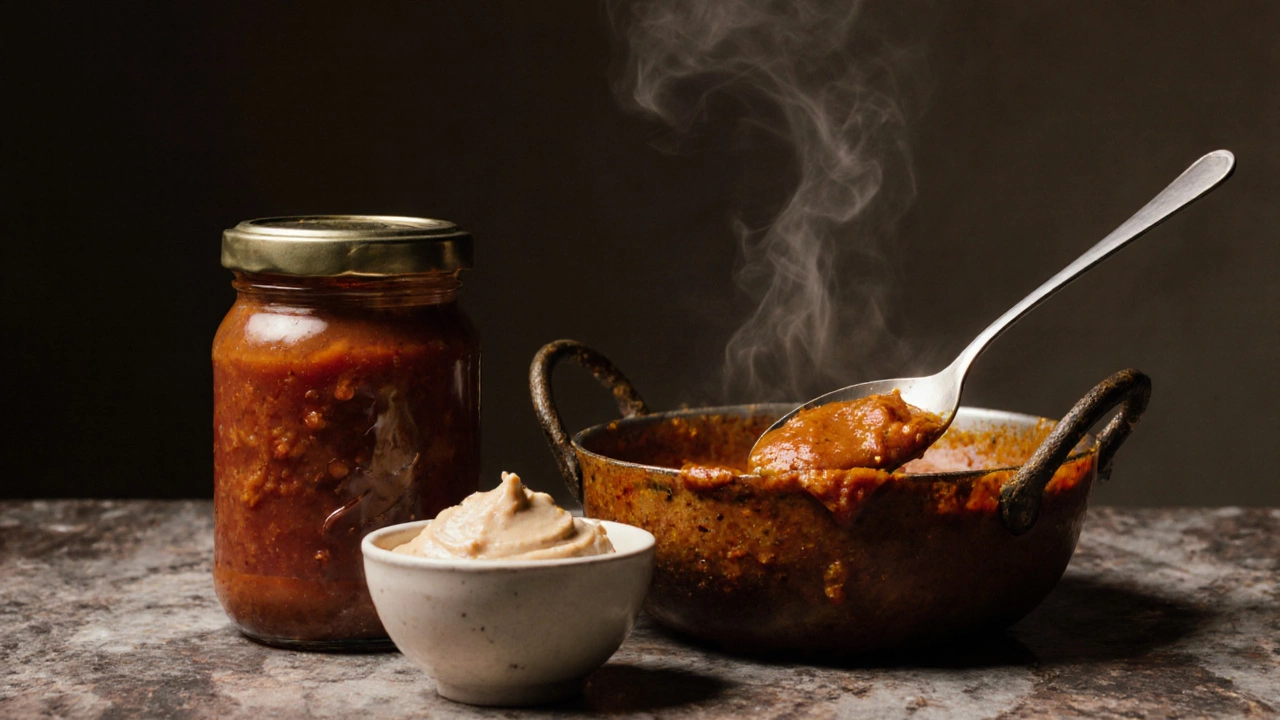How Indian Restaurants Make Curry So Thick

Ever bite into a rich, creamy chicken curry at an Indian restaurant and wonder how it’s so thick-like a velvety sauce clinging to every piece of meat-while your version at home ends up watery? It’s not magic. It’s technique. And it starts long before you add the spices.
The Base Is Everything
Most home cooks jump straight to onions, garlic, ginger, and spices. But in Indian restaurants, the foundation is built hours before the curry even hits the pan. They start with a slow-cooked base called masala. This isn’t just sautéed onions. It’s onions, tomatoes, and sometimes cashews or coconut, cooked down for 30 to 45 minutes over low heat until they collapse into a thick, jammy paste. No water. No shortcuts. The moisture evaporates, sugars caramelize, and the mixture turns deep brown. That’s where the body comes from.Think of it like making a French fond: the longer you cook, the more flavor concentrates. A restaurant might make a big batch of this masala on Monday and use it all week. It’s the secret behind the consistency you can’t replicate with a 15-minute stir-fry.
Ground Spices Don’t Do the Job Alone
Spices add flavor, not thickness. Turmeric, cumin, coriander-they dissolve into the oil and water, but they won’t thicken a sauce. That’s why restaurants use whole spices first. They toast cumin seeds, mustard seeds, fenugreek, and cardamom in hot oil until they pop. Then they grind them fresh into a paste with garlic, ginger, and a splash of water. Freshly ground spices release more oils and starches, which naturally thicken the sauce as they cook.Store-bought curry powder? It’s been sitting in a jar for months. The oils have gone stale. The starches are gone. You’re left with flavor without body.
Tomatoes Are the Hidden Thickener
Yes, tomatoes are juicy. But when you cook them down slowly-especially the paste form-they turn into a concentrated, sticky pulp. Indian restaurants use tomato paste, not just fresh tomatoes. They fry the paste in oil for 5 to 7 minutes until it turns from bright red to a brick-orange color. That’s the Maillard reaction at work. The sugars and acids break down, and the water evaporates. What’s left is a dense, almost caramelized layer that binds the sauce together.Try this: next time you make curry, use 2 tablespoons of tomato paste instead of one cup of chopped tomatoes. Cook it until it darkens. Watch how the oil separates from the paste-that’s your signal it’s ready for the next step.

Blending Is Non-Negotiable
You can’t get that restaurant silkiness by just stirring. After the masala base and spices are cooked, restaurants blend the entire mixture. Not just the onions and tomatoes-everything. The cooked spices, the garlic, the ginger, even the fried curry leaves. They use a high-powered blender or immersion blender until the sauce is completely smooth. That process breaks down every fiber, releasing pectin and natural gums that act like a thickener.Home cooks often skip this step because it’s messy. But skipping it is why your curry looks grainy and thin. Blend it. Even if you have to do it in batches. The texture change is dramatic.
Dairy and Nuts Add Body, Not Just Flavor
Cream, yogurt, or coconut milk? They help, but they’re not the main thickener. The real secret? Cashews. Or almonds. Or peanuts. Restaurants soak a handful of raw cashews in warm water for 20 minutes, then blend them into a smooth paste. That paste gets stirred into the curry at the end. It doesn’t make the dish taste nutty-it makes it creamy, rich, and thick without altering the flavor profile.It’s the same reason some curries use ground poppy seeds or sesame paste. They’re not flavor agents. They’re thickeners. A tablespoon of cashew paste can turn a runny sauce into something that coats the back of a spoon.
Simmering Is the Final Step
No matter how good your base is, if you don’t simmer, you won’t get the thickness. Restaurants don’t rush. After adding the chicken, they let the curry bubble gently for 45 to 60 minutes. The liquid keeps evaporating. The sauce reduces. The starches from the blended ingredients continue to swell. The fat from the meat melts and integrates. What you’re left with is a sauce that clings, not drips.At home, we often turn off the heat after 20 minutes. That’s why it’s thin. Let it simmer. Stir occasionally. If it’s still too runny after an hour, take the lid off. Let the steam escape. That’s how you get that restaurant texture.

What Not to Do
Don’t use flour or cornstarch. Yes, some home cooks do it. But in traditional Indian cooking, starches are a last resort-and rarely used in restaurants. They make the sauce cloudy, gummy, and unnatural. If you’re using flour, you’re compensating for a weak base, not building a real one.Don’t add water to thin it out. If your curry is too thick, add a splash of broth or coconut milk. Never water. It dilutes flavor and ruins texture.
Don’t skip the blending. Even if you think it’s fine. It’s the difference between chunky and luxurious.
Try This Simple Method
Here’s a no-fail way to get thick curry at home:- Use 1 cup chopped onions, 2 medium tomatoes, and 2 tablespoons tomato paste. Cook on low heat for 40 minutes until dark and jammy.
- Toast 1 teaspoon cumin seeds, 1/2 teaspoon fenugreek seeds, and 4 whole cardamom pods in oil until fragrant. Grind them with 1 inch ginger and 4 garlic cloves into a paste.
- Add the spice paste to the onion-tomato mix. Cook 5 more minutes.
- Blend everything until perfectly smooth.
- Soak 1/4 cup raw cashews in warm water for 20 minutes. Blend into a paste.
- Add chicken, salt, and 1/2 teaspoon turmeric. Simmer for 50 minutes with the lid slightly ajar.
- Stir in the cashew paste at the end. Taste and adjust.
That’s it. No flour. No cream. Just time, patience, and technique.
Why This Works
It’s not about one ingredient. It’s about layers. Each step-slow cooking, fresh grinding, blending, reducing, and adding nut paste-adds density. Restaurants do it because they have the time. You can do it too, even if you only have one evening. The key is to stop thinking of curry as a quick dish. It’s a slow ritual. And the thickness? That’s the reward.Why does my homemade curry always turn out watery?
Your curry is watery because you’re not cooking down the base long enough. Onions, tomatoes, and spices need at least 30 minutes of slow cooking to evaporate water and concentrate flavor. Adding water or skipping the blending step also keeps the sauce thin. Restaurants reduce their sauce by simmering for over an hour-home cooks often stop after 15 to 20 minutes.
Can I use cornstarch to thicken Indian curry?
You can, but it’s not traditional and it changes the texture. Cornstarch makes curry glossy and slightly gummy, which doesn’t match the natural silkiness of restaurant curries. Indian cooking relies on reduction, blending, and nut pastes for thickness-not starches. If you’re in a pinch, use a cashew paste instead-it thickens without altering flavor.
What’s the difference between restaurant curry and home curry?
Restaurants use a pre-made masala base that’s cooked for hours, blend everything into a smooth paste, and simmer for over an hour. Home versions often skip the slow cooking, use pre-ground spices, and don’t blend. That’s why restaurant curry feels richer and clings to the food, while home curry often feels watery and separates.
Do I need cream or coconut milk to get thick curry?
No. Cream and coconut milk add richness and flavor, but not thickness. The real thickener is the reduced onion-tomato base, blended spices, and nut pastes like cashew or almond. Many traditional curries don’t use dairy at all. The thickness comes from cooking technique, not added liquids.
Can I make the masala base ahead of time?
Yes, and you should. Making the masala base ahead saves time and improves flavor. Cook a big batch of onions, tomatoes, and spices until thick and dark, then store it in the fridge for up to 5 days or freeze it for months. When you’re ready to cook, just add your protein and simmer. This is how restaurants do it-and it’s the single biggest upgrade to your home cooking.